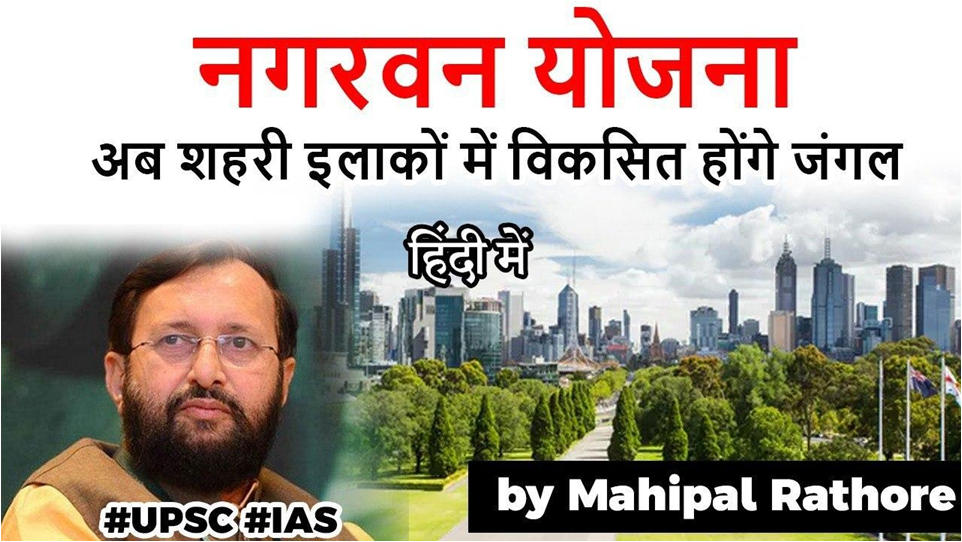Table of Contents


The Nagar Van Yojana
- Nagar Van Scheme was announced on the occasion of the World Environment Day (5th June).
- The scheme was announced by the Ministry of Environment, Forest and Climate Change (MoEFCC)
- India has decided to focus on Urban Forests in addition to the official theme.
World Environment Day
- Since 1974, it has been celebrated every year on 5 June: engaging governments, businesses, celebrities and citizens to focus their efforts on a pressing environmental issue.
- The theme of World Environment Day 2020 was ‘Celebrating Biodiversity‘
- Biodiversity is a concern that is both urgent and existential.
- Recent events, from bushfires in Brazil, the United States, and Australia to locust infestations across East Africa – and now, a global disease pandemic – demonstrate the interdependence of humans and the webs of life, in which they exist.

Urban Forests
- In many countries there is a growing understanding of the importance of urban forests.
- Cities like Rio de Janeiro and Johannesburg have large forests within their urban areas.
- In India, most cities have gardens and parks, but not forests.
Importance of Urban forests
- Urban forests play an important role in ecology of human habitats in many ways.
- Biodiversity conservation has traditionally been considered confined to remote forest areas but with increasing urbanisation a need has arisen to safeguard and save biodiversity in urban areas also
- Aside from the beautification of the urban environment, they offer many other benefits.


- The World Economic Forum says that cities that have more trees are less noisy, with lower pollution levels.
- A fully-grown tree can annually absorb up to 150kg of carbon dioxide (CO2) – one of the main greenhouse gases contributing to global warming.
- Trees can moderate temperatures in heavily built cities, where heat radiated from concrete on buildings and roads, makes these areas hotter than the surrounding countryside, in a phenomenon known as ‘heat island’
Warje Urban Forest, Pune
- The Warje Urban Forest has become a role model for the rest of the country
- Before becoming a pioneering urban forest, Warje Hill was a barren land under the Maharashtra Forest Department.
- As the city grew, it caused many encroachments by slums and builders.
- Maharashtra Forest Department joined hands with TERRE Policy, a city based NGO, Tata Motors and Persistent Foundation to turn the barren hill into a green forest.
Smriti Van concept
- To ensure that this project remained sustainable, peoples’ participation was encouraged. People can adopt trees in memory of their loved ones.
- Smriti Van today boasts of more than 6,500 grown up trees.
- Today, the forest is rich in biodiversity with 23 plant species, 29 bird species, 15 butterfly species, 10 reptiles and 3 mammal species. Five water ponds have been built and two watch towers constructed.
- Nearly 1000- 1500 people visit Smriti Van every day.
The Nagar Van Yojana
- The Nagar Van (Urban Forests) aims to develop 200 Urban Forests across the country in the next five years.
- A City Forest will be developed in each City with Municipal Council.
- The Scheme enforces people’s participation and collaboration between the Forest Department, Municipal bodies, NGOs, Corporates and local citizens.
- These urban forests will primarily be on theexisting forest land in the City or any other vacant land offered by local urban local bodies.
- Ecological rejuvenation of the city-Forests – the green lungs will contribute to Environmental improvement of cities by pollution mitigation, cleaner air, noise reduction, water harvesting and reduction of heat islands effect.
Financing
- The finances for the scheme will be paid for by the CAMPA (Compensatory Afforestation Fund (CAF) Act, 2016) funds.
- The CAF Act was enacted to manage the funds collected for compensatory afforestation which till then was managed by ad hoc Compensatory Afforestation Fund Management and Planning Authority (CAMPA).
- Compensatory afforestation means that every time forest land is diverted for non-forest purposes such as mining or industry, the user agency pays for planting forests over an equal area of non-forest land, or when such land is not available, twice the area of degraded forest land.
- As per the rules, 90% of the CAF money is to be given to the states while 10% is to be retained by the Centre.
Latest Burning Issues | Free PDF






















 WhatsApp
WhatsApp